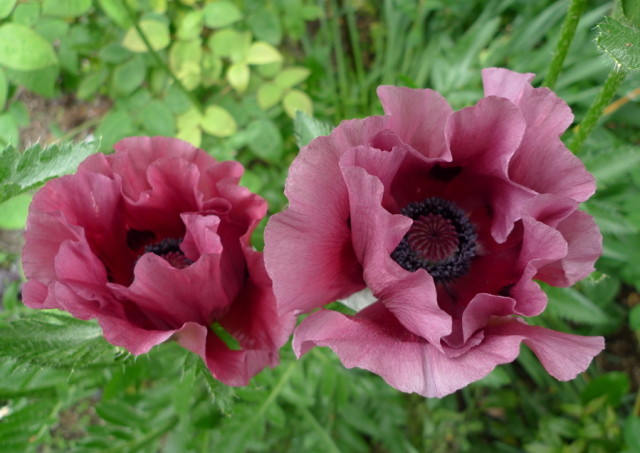Oriental Poppies

The weirdly beautiful Patty’s Purple Oriental poppy. I am looking for the perfect colors to pair with it in a new bed in my garden. Any suggestions?
Oriental poppies are drought tolerant in our climate. Did you know that?
I used to consider it a drawback that the foliage of Oriental poppies would disappear after flowering, leaving a bald spot in the middle of the garden. But since I figured out how to plant other flowers around it to conceal the withering foliage, I can better appreciate what that summer die-back means: Oriental poppies (Papaver orientale) actually rest (go dormant) in summer – meaning, they need no supplemental summer water, and make a wonderful contribution to a parking strip or other kind of dry garden.
And they’re just so frilly and frivolous in flower – with giant flowers that create tremendous splodges of color that cannot be overlooked. Just walk down nearly any street in Portland right now and you’ll come face-to-face with the huge orange crepe-paper flowers floating nearly at eye level. But there are also white, pale pink, bicolor, and – my favorites – blood-red (look for the cultivar ‘Beauty of Livermere’) and the truly peculiar ashy-pink-purple cultivar called Patty’s Purple (pictured above).
The best position for Oriental poppies is in the middle of a border or garden bed, where their huge, showy late May-June flowers float above plants in front of and behind it. Then, as the flowers shatter and drop off, other garden plants grow up over it and hide the foliage as it turns brown and withers in July when the dry weather hits.
If you do water your garden in summer, Oriental poppies will often retain their foliage or die down and immediately sprout a fresh rosette of new leaves that just sit there until the following spring. But if you don’t water during the dry period from approximately July to September, rest assured knowing those fat white poppy roots are deep in the ground, full of energy, just waiting for the first rains of autumn to send up a fresh little crown of leaves.
Plant: Oriental poppy (Papaver orientale)
Native habitat: rocky slopes and dry meadows throughout the Caucasus, northeastern Turkey, and northern Iran
Size: 16" to 4’ tall. Wet springs make them grow taller! They get about 2’ wide before they need to be divided.
Culture: Oriental poppies do best in well-drained soil in full sun, although they can take light shade under deciduous trees, as long as they receive plenty of sun early in the season.
